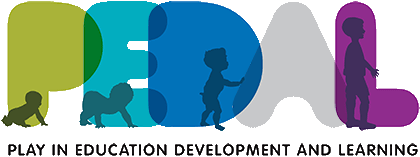Why does play matter?
Play is something of an evolutionary enigma: why do all mammals engage in a behaviour that uses valuable energy and makes them vulnerable to attack, at a time in their life when they are already highly vulnerable?
One possible answer is that play is important for early development, and we are only just beginning to understand how and why this may be the case. Despite the fact that adults often refer to play as a frivolous activity – a distraction from more serious things – there is mounting evidence that it is a significant driver of learning and development, especially in infancy.
As a highly diverse activity that includes (among other things) play-fighting, running, climbing, communicating, problem-solving, competition and collaboration, play encompasses many aspects of early development. In infancy, a dominant form of play is ‘free play’ – play with no particular aim other than having fun and exploring the world. Free play allows a child to encounter and interact with objects, people, sounds, ideas and emotions in a safe context, providing a stress-free environment for learning about the world.
Free play can also include physical play, such as play-fighting or tickling, and even something as apparently mindless and simple as this can have hidden depths. Research suggests that physical rough-and-tumble play early in life may relate to the development of social and emotional skills, and when you consider what is actually involved in such an activity, this makes sense1. Physical play means knowing how to signal a play episode instead of genuine conflict; understanding your partner’s intentions; reading your partner’s emotional state to know if they are having fun (and know if you accidentally hurt them). Consequently, it may be one way a child can learn about reading other people, and perhaps about how to navigate the boundary between pretence and reality.
In addition to free play, infants engage in some rudimentary forms of structured play. Along with other researchers, I have proposed that play is best conceived on a spectrum, ranging from free play at one end to didactic teaching (non-play) at the other2. In between these two extremes come activities which embed play in some form of structure, including board games and guided play.
Supporting guided play
Guided play is a type of play which involves an adult directing a child towards certain learning goals while maintaining the playful nature of the activity3. This is not necessarily easy to do, and many adults fall into the trap of taking over the activity, removing the child’s choice and agency, and changing what was play into something more like a lesson. In other words, they move the activity too far along the spectrum towards structured teaching, and in doing so, remove the potential learning benefits play could provide.
To instigate a genuine episode of guided play, the best approach may be for the adult to first and foremost see the activity as play, but also keep the learning goals in mind. The adult should be playing too; letting the child make choices and then elaborating on those choices with statements or actions that are consistent with the learning goals. This means the exciting, exploratory nature of play is retained, but the adult also points out or subtly directs the child towards learning opportunities as they present themselves.
To some degree, this involves reading the child’s mental state and responding appropriately to their needs, and we know from the results of many studies that doing this successfully is important for children’s learning and development. In one study, we looked at parent-child play across the second year of life, and found that infants whose parents gave them some support when they were struggling, and withdrew support when they were succeeding, performed better on measures of behaviour control later in life4. As one of the main forms of parent-child interaction in infancy, play is a primary context for contingent parental responding and the mutual reading of mental and emotional states.
Moving forward…
Overall, the evidence shows that infants do learn through play, although there are still many unanswered questions about the extent of this learning, and when and how it occurs. Through further research into play’s role in early development we hope to discover how to harness its benefits more effectively, helping us foster happier, healthier children at home and in school.

References
1The role of play in children’s development: a review of the evidence (Whitebread et al., 2017)
2Accessing the Inaccessible: Redefining Play as a Spectrum (Zosh et al., 2018)
3Guided Play: Principles and Practices (Weisberg et al., 2016)
4Maternal scaffolding during play with 12- to 24-month-old infants: stability over time and relations with emerging effortful control (Whitebread et al., 2019)

